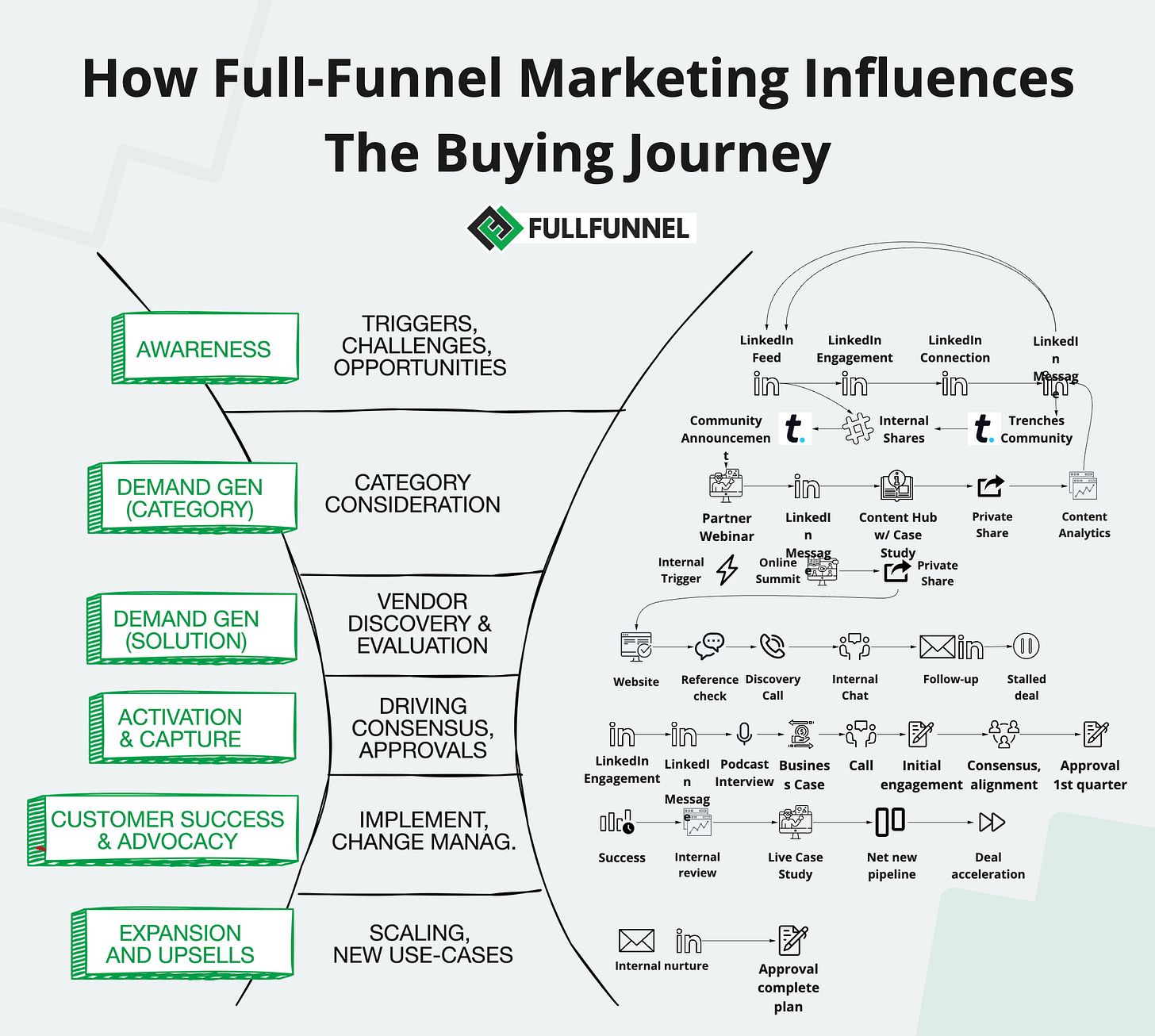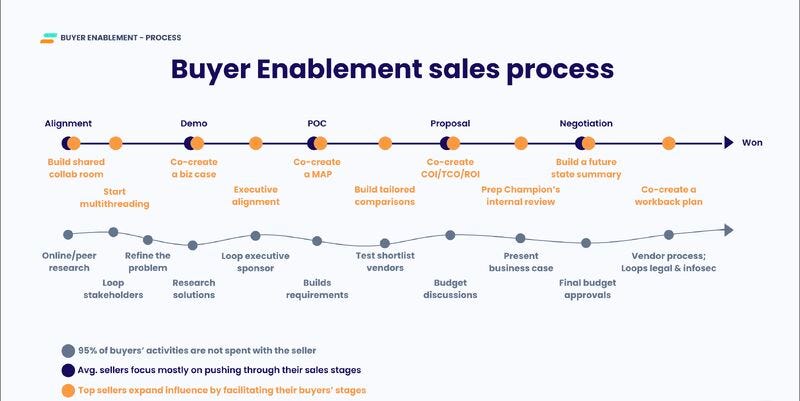You probably think sales reps close deals. But the data’s in. Over 90% of B2B buying happens during internal meetings—not sales meetings.
Which means deals are won and lost when you are not in the room.
This is my favorite quote from Nate Nasralla that perfectly explains why you MUST invest in buyer enablement.
In this issue we’ll cover:
How the B2B buying process happens, with an overview of a real buyer journey
How to prepare a buyer enablement program
How the B2B buying process happens
Buyer journey ≠ your marketing funnel or sales stages. Here is how the B2B buying process happens.
Here is how B2B buyers buy:
Run asynchronous research online, in communities, or through peers.
Add vendors to the consideration set when they find something interesting or relevant to organizational priorities.
Refine with the team and executives the key challenges, areas for improvement, and key priorities.
Research different solutions to their problem and weigh the alternatives
Loop executive sponsor who owns the budget and agrees to selection criteria
Develop requirements for the vendor to select the best solution
Reach out to prioritized vendors
Discuss budgets with those who met initial requirements and left a positive impression
Create an internal presentation or business case to get purchase approval.
Finalizing the deal with the vendor
Vendor onboarding
While it sounds linear, in reality it isn’t. Your buyers might not take all the steps, or might return to previous steps multiple times.
You need to understand what might influence them to move to the next step in the journey.
Here is a documented buyer process of an enterprise deal we won, described by our Champion (CMO of 5000+ B2B tech company): 8 months from the first touch to contract.
While we spoke many times about buyer journey and how to influence it with sales and marketing programs, I’d love to highlight what happened when we started the conversation.
Drive pipeline THIS quarter with full-funnel ABM programs.
If any of these challenges sound familiar:
You are aligned in theory with sales but don’t do anything in practice aside from receiving wish lists from sales and sharing with them your marketing plan. In reality, you work in silos and miss the revenue targets and are being pressured by your executives.
You understand that your marketing and sales playbook is broken (mqls, gated content) but despite many attempts you don’t know how to fix it
Your outbound, paid ads and organic pipeline drastically decreased while CAC increased mostly because most of your market is problem unaware and not buying.
You lack brand awareness among target accounts and sales can’t get even a reply.
You clearly see that you're already behind your revenue targets
We can help.
We'll develop a custom full-funnel ABM strategy aligned with your resources, budget and stack and execute it together to drive results THIS quarter.
How we think about the buying process vs how it actually happens
Here are the steps our client described after attending our webinar and receiving the content hub.
Internal buying trigger:
The CMO gets critical feedback about ROI, and ambitious KPIs for the next year
16. She sees a post about our summit, and asks her marketer to join and collect ideas
17. The demand gen marketer attends our session about full-funnel marketing
18. He shares a screenshot of our framework with his CMO
19. After seeing our framework shared by her marketer (and seeing our content and brand several times in the past), the CMO decides to check out our website, and recognizes one of our clients.
20. She reaches out and gets a positive recommendation
21. She asks the marketer to book a call with us.
22. After the discovery call, Vlad shares the content hub with the proposal along with a few key pieces of buyer enablement content.
23. The marketer presents our proposal, but gets a critical question about ROI he doesn’t know how to answer.
24. He stops responding to our follow-ups.
25. I engage with the CMO’s recent post, and follows up with a LinkedIn message, inviting her to our podcast. She agrees to join.
26. During the pre-production interview, he asks her about their challenges and priorities (to get the business context), and agrees with her on the topics to discuss during the main podcast interview.
27. After the main interview, I remind the CMO about how our proposal can help solve the challenges and help with priorities she shared in the pre-production interview. She shares her concerns and critical questions
28. We agree that we’ll help the marketer work out the business case for internal approval.
29. With the marketer, we create the business case, share a relevant case study and references.
30. CMO asks the marketer to check two more references.
31. After positive reference checks, the CMO books a call, and asks a few more critical questions.
32. We agree to start with a simple, low-ticket alignment and planning sprint.
33. During the sprint, we help drive internal consensus and alignment, and get the buy-in for a marketing plan to reach their new KPIs/
34. The CMO decides to hire us to guide the implementation, and gets an approval for the first quarter to work with us.
As you see, the buying process was very different from how we assume it is.
A lot of B2B teams still leave in their siloed "sales stages" world measuring the conversions between MQLs -> discovery calls -> POC -> Proposals -> Won/Lost.
They don't understand what's happening on the buyer's side and don't influence the internal buying process.
It is a huge gap that costs millions of dollars.
The best ABM teams create buyer enablement programs that facilitate these stages:
Establish their presence and engage with target buyers in the channels they use for research.
Provide an overview of the best solutions and industry best practices through thought leadership and content
Prepare personalized content hubs with the most common questions, industry case studies, etc. for their Champions
Update content hub regularly with the newly collected insights
Create business cases early with the Champions to facilitate internal sales
Start multi-threading with the buying committee group to create awareness
Add to business cases implementation plans, cost of inaction, milestones, ROI and other critical documents to address the concerns from key executives
Here is how we create a buyer enablement program.
GET ACCESS TO A NEW FULL-FUNNEL ABM 2.0 COURSE
What's included with the course access:
12 modules covering step-by-step ABM strategy development: goal decomposition, ICP, account list building, ABM team, warm-up and activation playbooks, reporting, scaling ABM and building a cohesive ABM & demand gen function.
Short explanation videos and "how to" examples. We believe it's better one time to see a practical example then listen to the theory hundreds of times.
5 orchestrated and ready-to-use ABM playbooks and a detailed explanation
Report dashboard for 4 types of ABM programs: new revenue, pipeline acceleration, expansion and churn prevention
Live case studies and examples of the campaigns we implemented with the clients of Fullfunnel.io in the past few years
17 templates to simplify your ABM strategy launch: ICP, revenue analysis, intent data tracking, account warm-up cadence, customer research, account scoring and prioritization, ABM budget planning and forecasting, account planning, reports, personalized offers, and many more.
Planning & Presenting a Pilot ABM Program to Execs and Sales Framework
Minimal viable stack recommendation and guidelines on how to use it to avoid ramping up budget and being pressured to show ROI for the purchased $50k software
How to create a successful buyer enablement program.
Here is our approach.
𝟭. 𝗥𝘂𝗻 𝗶𝗻-𝗱𝗲𝗽𝘁𝗵 𝗶𝗻𝘁𝗲𝗿𝘃𝗶𝗲𝘄𝘀 𝘄𝗶𝘁𝗵 𝗿𝗲𝗰𝗲𝗻𝘁 𝗰𝘂𝘀𝘁𝗼𝗺𝗲𝗿𝘀.
Ask:
What questions did they have during the buying process?
Who was also involved in purchasing, and what information did they require?
What influenced their decision to buy your product?
How do they see your product as different from the competition?
Watch this episode of Full-Funnel Live where we break down the process in more detail.
2. 𝗔𝘁𝘁𝗲𝗻𝗱 𝟱-𝟭𝟬 𝘂𝗽𝗰𝗼𝗺𝗶𝗻𝗴 𝘀𝗮𝗹𝗲𝘀 𝗰𝗮𝗹𝗹𝘀.
Listen and write down all the questions and concerns the prospects ask. Listen to what alternative they compare your product to.
3. 𝗔𝗻𝗮𝗹𝘆𝘇𝗲 𝟱-𝟭𝟬 𝗹𝗼𝘀𝘁 𝗱𝗲𝗮𝗹𝘀 𝘄𝗶𝘁𝗵 𝗜𝗖𝗣𝘀.
Extract all the information above + the reasons for losing the deal.
4. 𝗔𝗻𝗮𝗹𝘆𝘇𝗲 𝗶𝗻𝗱𝘂𝘀𝘁𝗿𝘆 𝗰𝗼𝗺𝗺𝘂𝗻𝗶𝘁𝗶𝗲𝘀.
Extract the questions different buyers ask about purchasing your product or competitive products. Look at the answers community members provide.
5. 𝗗𝗲𝗳𝗶𝗻𝗲 𝘁𝗵𝗲 𝗺𝗼𝘀𝘁 𝗶𝗺𝗽𝗼𝗿𝘁𝗮𝗻𝘁 𝗮𝗻𝗱 𝗿𝗲𝗽𝗲𝘁𝗶𝘁𝗶𝘃𝗲 𝗾𝘂𝗲𝘀𝘁𝗶𝗼𝗻𝘀, 𝗮𝗻𝗱 𝗰𝗿𝗲𝗮𝘁𝗲 𝗮 𝗰𝗼𝗺𝗽𝗿𝗲𝗵𝗲𝗻𝘀𝗶𝘃𝗲 𝗮𝗻𝘀𝘄𝗲𝗿.
There is no silver bullet for what type of content to create. Checklists, roadmaps, video overviews, case studies, step-by-step guides, comparison reports, ROI calculators - everything works.
Just think about what might be more convenient and valuable for your buyer.
Here is a detailed guide that reveals our account-based content strategy, including personalized 1:1 content: https://fullfunnel.io/abm-content/
Listen to Full-Funnel Live - 𝗗𝗲𝗺𝗮𝗻𝗱 𝗚𝗲𝗻𝗲𝗿𝗮𝘁𝗶𝗼𝗻 𝗶𝗻 𝗔𝗰𝘁𝗶𝗼𝗻: 𝗥𝗲𝗮𝗹-𝗪𝗼𝗿𝗹𝗱 𝗘𝘅𝗮𝗺𝗽𝗹𝗲𝘀.
*If you want to attend the next live episode, sign up here to receive an invite. Usually, we host them every Wednesday at 4 pm CET (Central Europe) - 10 am ET (Eastern Time).
In this episode of Fullfunnel Live, we shared behind-the-scenes and real world examples of demand generation in action.
Tune in to learn:
How to influence senior enterprise buyers who don't spend their days hanging out on LinkedIn
What is the role of sales in demand generation and capture
Why most B2B companies target the wrong audience with their demand gen programs
How to measure the impact of your demand gen programs (including the "dark social")
The most common objections sales and executives have, and how to address them
Subscribe to the Full-Funnel podcast:








